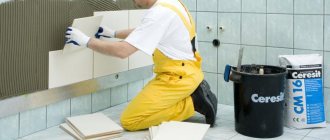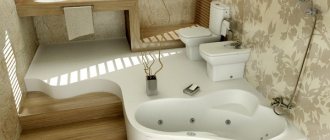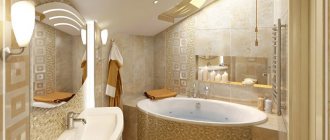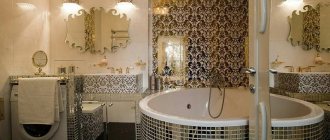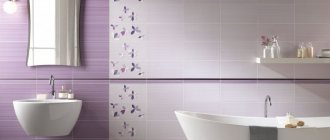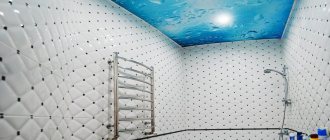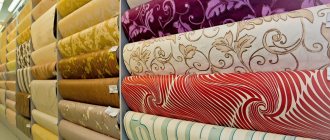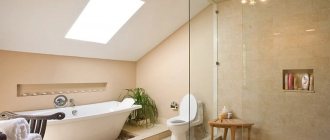Carrying out finishing work in the bathroom and toilet is one of the most important stages of renovation. Puttying walls or ceilings is necessary to obtain a decent result. It is worth noting that preparing a shower room for painting with your own hands is not particularly difficult. However, you should know some nuances, the sequence, as well as the characteristics of the material used.
All this will allow you to carry out repairs competently and without unnecessary problems. In addition, before applying putty for painting, you need to take into account the parameters of the room. In the absence of proper experience, performing these activities for the first time may seem like a rather difficult task.
But after some practice, certain skills emerge that greatly facilitate the process of finishing the walls and ceiling in the bathroom. To overcome yourself, you need to rely only on your own patience, as well as the desire to complete what you started. After leveling the surface, you can safely begin painting it and other types of necessary work.
Why is moisture-resistant putty needed?
Often, preparing the surface for finishing involves leveling uneven areas and applying a layer of putty. But it is important to select the purpose and type of mixture depending on the room. Not every putty is suitable for a wet room. If it is chosen incorrectly, the entire repair will not live up to expectations. Therefore, it is imperative to use moisture-resistant putty for the bath.
It is applied to all surfaces that are exposed to water and moisture in various forms. So, this can be the direct contact of water or moisture on the surface, the formation of evaporation or condensation. If you do not treat the walls and ceiling with this composition, the paint will peel off very quickly, and the entire repair will not justify the investment and everything will have to be redone.
Putty for wet rooms should be used not only in the bathroom and toilet. It is ideal for the kitchen, pool and bathhouse. The cost of such material is slightly higher than usual, but it pays off almost instantly after the repair is completed. Mold will not appear under the ceramic tiles, and the paint will last a very long time and will not lose its original shade. The surface will remain perfectly flat, which is important for subsequent decorative finishing.
What tools are needed?
Puttying begins with preparing the necessary tools and materials. This is necessary so that the process of covering the wall with a paint base goes on non-stop and is not interrupted by trips to the store to buy additional products. Of course, the process of treating a wall is impossible without putty. You will need:
- basecoat and topcoat;
- three types of spatulas necessary for plastering walls, wide, narrow and angular;
- sandpaper or a special mesh for sanding.
- primer mixture and a roller with which it is applied to the wall.
- You will also need to carry out repair work using a hammer drill.
Main types
Waterproof putty for the bathroom is available in several types. Each mixture has its own advantages, which are necessary for certain conditions. To choose the right option, you need to familiarize yourself with the main putty options:
- Cement. This is a material with increased resistance to moisture. This composition is ideal for application to the walls and ceiling in the bathroom of a house or apartment. Cement putty is inexpensive, which makes it accessible to most buyers. Negative aspects include a grayish tint and a grainy structure. It should not be used in combination with white or other light-colored paint.
- Plaster. This bathroom putty has a pleasant light shade. The mixture dries quickly and ideally prepares the surface for painting with pastel colors. The putty is applied in an even layer, which makes subsequent finishing easier. But this material is used only for indoor work. It is not suitable for working with facades. This is due to the fact that gypsum does not tolerate temperature changes well.
- Polymer. This finishing mixture represents an advanced development. It consists of high-tech particles, and the process is high-tech particles, and the polymerization process is carried out in contact with air. The moisture-resistant putty remains plastic for a long time, so you can work with it slowly. But with such compounds a respirator is required.
- Oil-glue. This material is a powder mixture that requires dilution. This putty layer is ideal for utility rooms that do not need high-quality repairs.
On video: how to plaster the walls in the bathroom.
Special approach
Putty consists of a whole mixture of various components, in which coarse-grained particles play the main role. They allow the solution to more thoroughly level the surface of the wall or ceiling in the shower room. After applying the putty, it is best to wait for it to dry completely, and then wipe and rub it thoroughly. Otherwise, application to a damp and unprepared base will result in a lack of high-quality coating. Various flaws, irregularities, and roughness will be visible. You can glue waterproof wallpaper to finished walls in the bathroom, but then you will need putty made from smaller particles.
In order to properly apply putty to the wall or ceiling in the bathroom, you need to select the right tool. For example, a wide spatula is best for comfortable work. In some respects, it looks more like a spatula with a thin metal base. When applying putty with this device, you can feel all the bends and unevenness of the surface. This is very helpful when working and also makes it much easier.
The putty should be applied in a layer of no more than 2–3 mm, however, this indicator directly depends on the degree of unevenness of the ceiling or wall. In order for the mixture to dry, you need to wait a certain period of time. The most reliable drying method is natural. Artificial methods in the form of various heat sources, convectors or ventilation systems will lead to premature drying, which will result in the appearance of cracks.
Properties
Puttying of walls in the bathroom and other wet rooms is carried out before subsequent painting or finishing the surface with ceramic tiles. Regardless of the decorative layer, the putty should have the following properties:
- high resistance to moisture, which preserves the putty even after decades;
- resistance to temperature changes that are typical for the bathroom and kitchen;
- environmental friendliness, since the mixture must be safe for human health;
- affordable cost, which is important when applied to a large area.
As a result, you should have a durable and strong layer that is ideal for the ceiling and walls in the bathroom. It should interact well with the tiles and the coloring composition. If you plan to apply bright or dark paint, you can go with a cement mixture. If you are looking for a composition for walls to paint, pay attention to the Vetonit polymer mixture.
These properties are basic. In a specific situation, it is necessary to be guided by the most important qualities for the room.
One of the most versatile is Knauf plaster, which allows you to create any design solutions even in the wettest rooms.
Insulation materials
The bathroom is a room with high humidity, therefore, for finishing the walls, it is necessary to use a special moisture-resistant putty. This composition, when exposed to moisture, improves performance characteristics and becomes more durable. We will learn further about how to finish the walls in the bathroom using moisture-resistant putty.
Table of contents:
Moisture-resistant putty for the bathroom: application features
The putty used to finish the walls in the bathroom must have certain properties that ensure the quality of its use. Regardless of the further finishing of the walls in the room, the putty for the walls in the bathroom should be:
- resistant to moisture - ordinary putty, under the influence of moisture it swells, peels off, deforms and generally collapses, while moisture-resistant materials should become stronger under the influence of moisture;
- long-lasting - the minimum service life of the putty after its application to the walls should be twenty years;
- resistant to changes in temperature - since the bathroom is a room with an unstable temperature regime, the putty for walls should easily tolerate these fluctuations; expansion and contraction of the putty when the temperature changes leads to its destruction.
Please note that these criteria are decisive when choosing a putty composition for finishing bathroom walls. Individual additions depend on further wall finishing. So, for example, if after finishing the walls in the bathroom are painted, then the surface should be perfectly even, which means the putty should fit perfectly on the wall. For walls finished with tiles, this criterion is less important.
Features of working with moisture-resistant putty
Any putty for bathrooms, pools and other wet areas gains hardness within 24 hours after application. High-quality compounds have increased elasticity. They cover the surface with an even layer and have good adhesion to the main surface. Knauf plaster with a moisture-resistant effect makes it possible to well protect the base and install finishing with high decorative qualities.
Cement-based mixtures such as Vetonit contain plasticizing components and pigment dyes. The result is an optimal putty for a bathroom to be painted.
Some compositions can be used in facade work. But they can also be used to treat interior surfaces. Vetonit putty mixture, intended for facade work, is suitable for use on walls in damp rooms. This is a great solution if you have some mixture left after working on the outside surface of the walls. But you can also purchase a special composition for rooms with high humidity.
A feature of most modern mixtures is that there is no need to purchase special tools. The compositions are used on a primer layer, which can be applied manually. After this, leveling is carried out, repairing all irregularities and minor defects.
Advice! On critical areas of the surface it is necessary to apply another layer of a mixture with a moisture-resistant composition. This is important if you are using putty under tiles.
Choosing a manufacturer
When buying a mixture for plastering a bathroom for painting, it is better to avoid unnecessary savings. External indicators and reliability of the coating will depend on its quality. There are several brands that have earned the trust of consumers. Rotband and Vetonit can be considered the most famous. Dry, ready-made formulations can be found on sale. Subject to all conditions, proper preparation and application, the quality of work will delight you for a long time. Unlike plaster, the cost of the substance to carry out putty will be insignificant. You can find very small amounts of the composition.
Among the most popular types are:
- Vetonit VH is used for wet rooms, developed on the basis of cement. A layer of two millimeters. It will be dry in just a couple of days;
- Vetonit KR+. Polymer based mixture. Dry within 24 hours. Layer up to five millimeters;
- Vetonit KR. Glue-based substance. Dries in a day. Gives a layer of up to three millimeters.
Subtleties of choice
When using putty for a pool or kitchen, you must be careful and take your time. It is important to study the presented range in order to choose the right product. After familiarizing yourself with Knauf positions, study the instructions for using the mixture.
Give preference to the one that has the composition and necessary properties that are acceptable to you. As a result, you will get a waterproof surface that is completely protected from moisture. It is worth considering that the Knauf waterproof mixture dries faster than the standard one.
Pay attention to the term hydrophobicity. If it is present on the package, the finished mixture must be applied in 2 layers. As a result, painting will be simple and of high quality, and the coating will remain in its original form for many years. When purchasing Vetonit plaster, keep in mind that it must match the material being processed.
The mixture with coarse sand is suitable for brickwork. And if you need to process smooth blocks, give preference to mixtures with fine quartz sand.
Varieties
Bathroom putty is divided into several types. Which one is best? To do this, you need to understand the division of the material. The mixture is divided into separate categories depending on the main component, as well as its purpose. For example, according to the degree of readiness, the putty can be ready for use or in the form of a dry mixture.
For premises characterized by difficult operating conditions, i.e. For a kitchen or bathroom, it is best to select polymer or cement-based building compositions. It is these mixtures that have the necessary level of protection against microorganisms, corrosion, and cracks. To get to know each composition in more detail, you need to find out all their strengths and weaknesses. Kinds:
- Cement. One of the main advantages of the material is its high resistance to moisture. Therefore, the mixture is recommended for use in the bathroom for application to walls and ceilings. The cost of the material is at an affordable level, and the characteristics are highly rated. The downsides include a grainy structure and a grayish tint. This makes it difficult to combine with different colors, especially white. The composition takes a long time to dry, is subject to shrinkage, the room must be regularly ventilated.
Wall preparation and puttying
When processing any surface, it must first be prepared. Before applying Knauf plaster, completely remove the old finish. Pay attention to the need to remove dust, dirt and grease stains. Remove protruding elements such as screws and fasteners. They can be knocked down with improvised tools.
Next, the surface is disinfected. To do this, clean all damaged areas. It’s good if you treat the wall with an antiseptic composition. Then the surface must be primed. This is necessary because the primer ensures good adhesion of the materials to the surface.
Advice! Often cracks or holes appear between the seams on the ceiling and walls. They must be sealed with cement putty. If this is not done, the future finishing will not be of high quality.
At the final stage it is necessary to apply putty. But the packaging should be marked that it is suitable for wet areas. The surface not only becomes perfectly flat, but also becomes protected from steam and moisture.
The moisture-resistant composition is ideal for renovations in the kitchen and bathroom. This putty is indispensable for finishing a swimming pool. But follow the manufacturer's instructions as closely as possible.
Thus, putty has a direct impact on the appearance of the finished surface. It not only creates a perfect coating, but also protects it from moisture and steam. Moisture-resistant putty is an excellent solution for those planning renovations in the bathroom or kitchen. It is also indispensable in finishing swimming pools. The main thing is to follow the sequence of actions suggested by the manufacturer.


